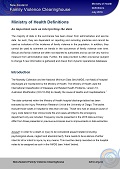 Definitions
Definitions
Prepared by the New Zealand Family Violence Clearinghouse
University of Auckland, July 2016
Read online below or download
For more information contact us
Downloads
Ministry of Health definitions, July 2016 (PDF, 154 KB)
Ministry of Health definitions, July 2016 (Word DOC, 316 KB)
Related documents
These definitions relate to Data Summaries
Ministry of Health definitions
An important note on interpreting the data
The majority of data in the summaries has been drawn from administrative and service data. As such, they are dependent on reporting and recording practices and cannot be used as indicators of the incidence of family violence in the population. In addition, they cannot be used to comment on trends in the occurrence of family violence over time. Sexual and family violence are often not reported to authorities and so can be very hard to measure from administrative data. Further, the data provided is often provisional (subject to change if new information is gathered) and drawn from dynamic operational databases.
Introduction
The Mortality Collection and the National Minimum Data Set (NMDS) of hospital discharges are maintained by the Ministry of Health. The Ministry of Health uses the International Classification of Diseases and Related Health Problems, version 10, Australian Modification (ICD-10-AM) to classify the cause of deaths and hospitalisations.[1]
The data contained within the Ministry of Health hospital discharge tables has been extracted by the Injury Prevention Research Unit at the University of Otago. The tables exclude those cases in hospital for less than one day. Those who had an assault cause of injury code listed in their clinical code file and cases admitted to the emergency department are included. Assault must be clearly recorded on the hospital notes to be assigned as such in the NMDS. Frequency counts presented in the 2016 data summary differ from those presented in previous summaries due to improvements in data extraction.
Assault: In order for a death or injury to be considered assault related (including psychological abuse, neglect and abandonment), there needs to be evidence of either intent to kill or intent to injure, by any means. This must be clearly recorded on the hospital notes to be assigned as such in the NMDS (see ‘Intent’ below).
Intent: According to the Australian coding standards, which New Zealand adheres to, coders cannot assume intent: intent must be clearly specified by the clinician in hospital notes or the coroner in mortality records.[2]
Relationships (between victim and perpetrator): It should be noted that for a proportion of assaults, the identity of the perpetrator is unknown to the health system or not recorded.
Family Member: Includes a perpetrator that is recorded as a: Spouse or Domestic Partner or Parent.
Other Family Member: Includes siblings, step-siblings, cousins, grandparents, grandchildren, aunts, uncles, nieces, nephews as well as sons and daughters.
Other Perpetrator: Includes a perpetrator who is recorded as a: Carer, Acquaintance or friend, Person unknown to the victim, Multiple persons unknown to the victim and Other specified person.
Unspecified Person: When the perpetrator’s details have not been recorded.
References
[1] National Centre for Classification in Health. (2002). Tabular list of Diseases. Volume 1 of The International Statistical Classification of Diseases and Health Related Problems, tenth revision, Australian Modification (3 ed.). Sydney: National Centre for Classifications in Health
[2] National Centre for Classification in Health. (2002). Australian Coding Standards for ICD-10-AM. Volume 5 of The International Statistical Classification of Diseases and Health Related Problems, tenth revision, Australian Modification. (3rd Ed). Sydney: National Centre for Classifications in Health.


